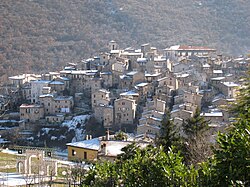Scanno, Abruzzo
Scanno | |
|---|---|
| Comune di Scanno | |
 | |
show Location of Scanno | |
 Scanno Location of Scanno in Italy | |
| Coordinates: 41°54′7″N 13°53′4″E / 41.90194°N 13.88444°ECoordinates: 41°54′7″N 13°53′4″E / 41.90194°N 13.88444°E | |
| Country | Italy |
| Region | Abruzzo |
| Province | L'Aquila (AQ) |
| Frazioni | Frattura |
| Government | |
| • Mayor | Giovanni Mastrogiovann |
| Area | |
| • Total | 134.68 km2 (52.00 sq mi) |
| Elevation | 1,050 m (3,440 ft) |
| Population (28 February 2015)[3] | |
| • Total | 1,883 |
| • Density | 14/km2 (36/sq mi) |
| Demonym(s) | Scannesi |
| Time zone | UTC+1 (CET) |
| • Summer (DST) | UTC+2 (CEST) |
| Postal code | 67038 |
| Dialing code | 0864 |
| Patron saint | St. Eustace |
| Saint day | 20 September |
| Website | Official website |
Scanno (Abruzzese: Scannë) is a town and district in the province of L'Aquila, in the Abruzzo region of central Italy.
The town is bordered by Anversa degli Abruzzi, Barrea, Bisegna, Bugnara, Civitella Alfedena, Introdacqua, Opi, Pescasseroli, Pettorano sul Gizio, Rivisondoli, Rocca Pia, Villalago and Villetta Barrea.
History[]
Situated in the Sagittario Valley and encircled by the Majella mountains, Scanno has been immortalised by photographers Henri Cartier-Bresson (1951) and Mario Giacomelli (1957–59) and, according to Edward Lear, was host to Italy's most beautiful women.[4]
Local legend has it that Scanno's natural lake (Lago di Scanno - stocked with pike and perch and Abruzzo’s largest natural basin) was created by a feud between a white witch and a sorcerer; the lake marking the spot where the witch finally fell.
People[]
For a brief period during World War II, future Italian president Carlo Azeglio Ciampi was a refugee in the town.
Quinto Mancini (1893–1963), the father of American composer Henry Mancini, was born in Scanno on 13 March 1893 and later emigrated to America.
Main Sites[]
- Hermitage of Sant'Egidio
- or Chiesa Matrice
References[]
- ^ "Superficie di Comuni Province e Regioni italiane al 9 ottobre 2011". Istat. Retrieved 16 March 2019.
- ^ "Popolazione Residente al 1° Gennaio 2018". Istat. Retrieved 16 March 2019.
- ^ All demographics and other statistics: Italian statistical institute Istat.
- ^ Lear, Edward (1846). Illustrated excursions in Italy.
- Cities and towns in Abruzzo
- Municipalities of the Province of L'Aquila
- Scanno, Abruzzo
- Hilltowns in Abruzzo
- Abruzzo geography stubs


